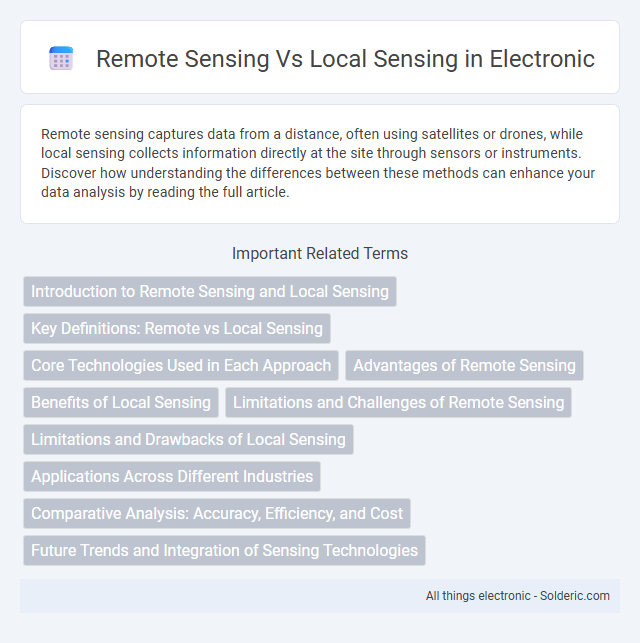Remote sensing captures data from a distance, often using satellites or drones, while local sensing collects information directly at the site through sensors or instruments. Discover how understanding the differences between these methods can enhance your data analysis by reading the full article.
Comparison Table
| Feature | Remote Sensing | Local Sensing |
|---|---|---|
| Definition | Collecting data from a distance without physical contact | Gathering data through direct, on-site measurements |
| Data Acquisition | Via satellites, drones, aircraft sensors | Using sensors placed directly on or near the target |
| Spatial Coverage | Large-scale regions, global to regional | Localized, specific points or areas |
| Resolution | Moderate to high, depending on sensor type | High, precise measurements |
| Applications | Environmental monitoring, agriculture, meteorology | Industrial process control, health monitoring, robotics |
| Cost | Higher initial investment, but cost-effective over large areas | Lower initial cost, but limited to small areas |
| Temporal Frequency | Periodic, based on satellite/drone revisit times | Continuous or real-time data collection |
| Limitations | Atmospheric interference, lower detail at times | Limited spatial scope, physical sensor maintenance |
Introduction to Remote Sensing and Local Sensing
Remote sensing involves acquiring data from satellite or aerial sensors to analyze Earth's surface without direct contact, enabling large-scale environmental monitoring and resource management. Local sensing collects information through ground-based instruments or in-situ measurements, providing high-resolution, real-time data critical for precision agriculture and localized climate studies. Both methods complement each other by offering varied spatial and temporal insights essential for comprehensive geospatial analysis.
Key Definitions: Remote vs Local Sensing
Remote sensing involves acquiring data about objects or areas from a distance, typically using satellite or aerial sensors to detect electromagnetic radiation reflected or emitted. Local sensing refers to collecting information directly at or near the target site through ground-based instruments, such as soil sensors, weather stations, or handheld devices. The fundamental difference lies in remote sensing's broad, large-scale monitoring capacity versus local sensing's high-resolution, site-specific data acquisition.
Core Technologies Used in Each Approach
Remote sensing relies on satellite or aerial platforms equipped with technologies such as LiDAR, multispectral and hyperspectral imaging, and radar to capture data from a distance, enabling large-scale environmental monitoring and mapping. Local sensing utilizes ground-based sensors including GPS devices, IoT sensor networks, and proximity sensors for real-time, high-resolution data collection within confined areas. Your choice between remote and local sensing depends on the spatial scale, resolution, and immediacy of the data required for your specific application.
Advantages of Remote Sensing
Remote sensing offers extensive coverage, allowing you to collect data over large, inaccessible, or hazardous areas efficiently without physical presence. It provides real-time monitoring and multi-spectral imaging, enhancing analysis in agriculture, environmental management, and disaster response. The non-invasive nature of remote sensing reduces costs and risks compared to localized manual data collection.
Benefits of Local Sensing
Local sensing provides higher accuracy and real-time data collection by capturing environmental conditions directly at the source, enabling immediate decision-making and precise monitoring. It reduces reliance on external data sources, minimizes latency, and enhances responsiveness in critical applications such as robotics, medical devices, and industrial automation. Cost-effective implementation and easier maintenance further contribute to its advantages over remote sensing in localized contexts.
Limitations and Challenges of Remote Sensing
Remote sensing faces limitations such as atmospheric interference, spatial resolution constraints, and data processing complexities that can affect the accuracy and timeliness of information. Cloud cover, sensor malfunctions, and the need for extensive calibration pose challenges in capturing reliable data over diverse terrains. Understanding these limitations helps you interpret remote sensing data more effectively and decide when local sensing may provide necessary ground-truth validation.
Limitations and Drawbacks of Local Sensing
Local sensing faces limitations such as a restricted spatial coverage and potential blind spots due to sensor placement, which can lead to incomplete data capture. The accuracy of measurements may be compromised by environmental factors like obstacles or interference within the immediate vicinity of the sensor. Your ability to monitor large-scale or dynamic phenomena is constrained, making local sensing less effective for comprehensive or real-time analysis compared to remote sensing technologies.
Applications Across Different Industries
Remote sensing enables large-scale environmental monitoring, agriculture crop health assessment, and disaster management by capturing data from satellites and drones across vast geographic areas. Local sensing excels in manufacturing automation, smart home systems, and healthcare by providing precise, real-time data through sensors embedded in machines, devices, and wearable technology. Together, these sensing technologies drive innovation in industry-specific applications such as precision agriculture, urban planning, and industrial IoT.
Comparative Analysis: Accuracy, Efficiency, and Cost
Remote sensing offers broad-area data collection with high efficiency but may sacrifice resolution accuracy compared to local sensing, which provides detailed and precise measurements at specific locations. Efficiency in remote sensing arises from its capability to cover large and inaccessible regions quickly, while local sensing demands more time-intensive, on-site data acquisition, increasing labor costs. Cost considerations favor remote sensing for extensive or repeated surveys due to reduced fieldwork expenses, whereas local sensing incurs higher costs related to equipment deployment and maintenance at each measurement point.
Future Trends and Integration of Sensing Technologies
Future trends in remote sensing emphasize higher-resolution satellite imagery and the integration of AI-driven data analytics to enhance environmental monitoring and urban planning. Local sensing technologies are advancing through the deployment of dense sensor networks and edge computing, enabling real-time, granular data collection for applications like smart cities and precision agriculture. The convergence of remote and local sensing through IoT platforms facilitates comprehensive, multi-scale monitoring systems that optimize resource management and disaster response.
Remote sensing vs Local sensing Infographic

 solderic.com
solderic.com